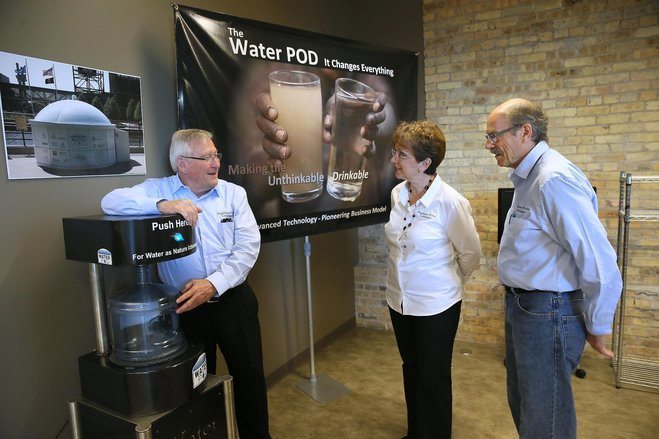By Don Behm
Milwaukee Journal Sentinel.
A sign on the white igloo perched next to the brown, murky water of the Menomonee Canal south of downtown says: “Making the Unthinkable Drinkable.”
A small hose carries the canal’s heavily polluted water inside the 8-foot-diameter dome.
A button on the outside can be pushed to dispense clear water that is clean enough to drink, said Anne Wick. She invites curious visitors — most recently Milwaukee Mayor Tom Barrett; Cheryl Bailey, dean of the School of Natural and Health Sciences at Mount Mary University; and Dean Amhaus, president and CEO of The Water Council — to taste the finished and fully tested product.
If there is any hesitation, she smiles and offers reassurance. “I’m a nurse so I wouldn’t offer it to you if it wasn’t safe,” said Wick, communications director for Stonehouse Water Technologies.
Her boss, Hensley Foster, plans to distribute the water treatment domes, and even smaller cupboard-size units, to communities in developing nations from the Caribbean to Africa that do not have access to clean water.
Drinking unsafe water is a global public health crisis, causing widespread diarrhea and 2.5 million deaths a year, according to Foster, president of Stonehouse.
His first unit to go overseas is destined for the Dominican Republic in October.
La Sagrada Familia Catholic Parish in the province of Azua has constructed a shallow well to serve local villagers, Wick said. Installation of the miniature treatment system will ensure that the water is safe to drink, and at a fraction of the cost that villagers now pay to street vendors selling poor-quality water.
La Sagrada Familia is a sister parish of the Milwaukee Archdiocese.
Catholic Relief Services is attracted to the unit’s simple, low-flow design — requiring little or no energy — and will be watching the outcome closely, Foster said.
Vanessa Tobin, a senior adviser on water supply and sanitation for the international humanitarian agency, told the company that she is considering using the units across Central America.
Local government officials from Kenya, in East Africa, have visited the company’s laboratory and office at the Global Water Center in Milwaukee to get a firsthand look at the units.
Foster credits The Water Council for helping Stonehouse succeed, starting with the offer of space at the center a few years ago and followed by an $80,000 grant awarded in January of this year for development of the small-scale water purification system.
Stonehouse received the council’s first Wells Fargo clean technology and innovation grant, aimed at moving water technologies from laboratories to the real world.
“If it wasn’t for that grant, we’d still be on the drawing board,” Foster said. “But we have a first-generation unit.”
The Water POD — for Potable On Demand — that grew out of the grant contains a series of filters that can be modified depending on pollutants in a local water source.
Filters remove sediment, illness-causing bacteria and Cryptosporidium, metals, chemical pollutants and odors. The final step is exposure of the water to ultraviolet light so that viruses are killed, he said.
Each POD produces 3,000 gallons a day, enough drinking water for 1,000 people, Foster said. He estimates the owner of a POD could charge customers about 31/2 cents per liter of water — slightly more than a quart — to pay costs of treatment and to sustain a business.
Though other companies are designing water purification systems for developing countries, he describes the POD as unique for several reasons.
It does not require a big diesel engine to operate large pumps and a trailer-size, or larger, treatment plant. His strategy is to place many small units at local water sources close to communities so residents don’t have to travel for safe water.
Gravity alone can push water through the low-flow filters if the source or a storage tank is elevated above a POD, he said.
If not, the unit can operate on just 12 volts of electricity and will work with energy generated from a solar panel.
The Water Council last week announced an additional commitment of $600,000 over two years — $300,000 from the Milwaukee Metropolitan Sewerage District and $300,000 from the Fund for Lake Michigan — to continue financing the clean technology deployment program launched by Wells Fargo.
The council later this year will ask water industry companies to apply for deployment grants focused on technologies for detecting and treating contaminants in storm water, and technologies for collecting and using rain water where it falls, said Vicki Elkin, executive director of the Fund for Lake Michigan.
The goal of the new partnership is “to pick up the pace of innovation and help entrepreneurs develop strategies to better and more effectively safeguard our water resources, ” Elkin said.














































































































































































































































































































































































